| |
|
Food and Wine Pairing Guide |
Carpe
Vinum members appreciate the magic of food and wine pairing.
Pairings when done well accentuate more from the wine and
the food alone can do.
When wine
is paired with the right food the combination can be amazing.
Subtleties are reveled and the combination of senses plays
off of each other.
Here we have provided
a few examples of wines and food that pair well. These are
just samples and by no means should they be viewed are hard
and fast rules.
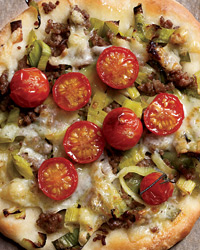 Leek-and-Pecorino Pizza with Pinot Noir or Dolcetto
Leek-and-Pecorino Pizza with Pinot Noir or Dolcetto
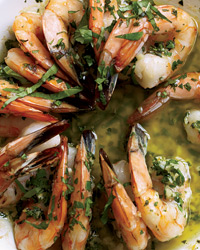 Shrimp Scampi with Full-bodied Chardonnay
Shrimp Scampi with Full-bodied Chardonnay
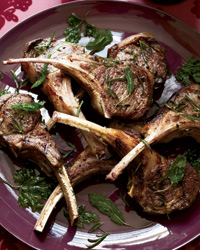 Lamb
Chops with Cabernet Sauvignon and Bordeaux-style blends
Lamb
Chops with Cabernet Sauvignon and Bordeaux-style blends
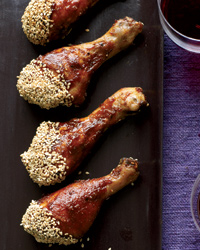 Barbecue with Malbec, Shiraz and Côtes-du-Rhône
Barbecue with Malbec, Shiraz and Côtes-du-Rhône
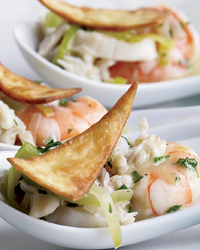 Seafood Tostada Bites pith Pinot Grigio or Arneis from Italy
or Chablis from France
Seafood Tostada Bites pith Pinot Grigio or Arneis from Italy
or Chablis from France
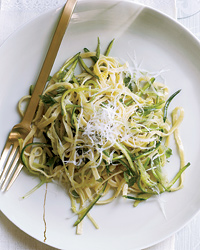 Zucchini Linguine Albariño from Spain and Vermentino
from Italy
Zucchini Linguine Albariño from Spain and Vermentino
from Italy
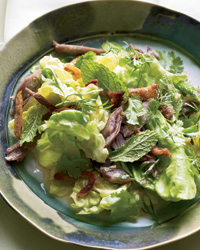 Thai Green Salad with Rieslings, Gewürztraminers and
Vouvrays
Thai Green Salad with Rieslings, Gewürztraminers and
Vouvrays
Food
and Wine Pairing Guide
The following wine pairing guide table provides some common
parings for foods with red and white wines.
| |
White |
Red |
| Wine
and Cheese |
|
|
| Asiago |
|
Bardolino,
Chianti, Zinfandel |
| Bel Paese |
Chardonnay |
|
| Blue |
Sauternes |
Port,
Madeira, Sherry |
| Brie |
Champagne, Sweet Sherry |
Pinot
Noir, Merlot, Beaujolais |
| Camembert |
Chenin Blanc |
Pinot
Noir, Cabernet |
| Cheddar |
Chardonnay |
Cabernet,
Rioja, Sauvignon Blanc |
| Feta |
|
Beaujolais |
| Goat |
Sauvignon
Blanc, Sancerre, Vouvray |
Merlot |
| Gorgonzola |
Sauternes |
Bordeaux |
| Gouda |
Riesling,
Champagne |
Cabernet,
Pinot Noir |
| Gruyere |
Chardonnay,
Pinot Grigio, Sauvignon Blanc |
Port |
| Manchego |
|
Rioja,
Ribera del Duero, Merlot, Malbec |
| Parmesan |
|
Barolo,
Barbaresco, Brunello di Montalcino, Chianti |
| Provolone |
Chardonnay |
Chianti,
Barolo |
| Swiss |
Asti
Spumante, Gewürztraminer |
Chianti |
| Stilton |
|
Port |
| Wine
and Seafood |
|
|
| Caviar |
Champagne, Riesling |
|
| Salmon |
Chardonnay |
Pinot
Noir |
| Oysters |
Champagne |
|
| Shellfish |
Chardonnay,
Sauvignon
Blanc, Burgundy (White) |
|
| Shrimp |
Orvieto, Soave, Vinho Verde |
|
| Spicy
seafood |
Gewurztraminer |
|
| Sushi |
Sake,
Riesling, Sancerre |
|
| Wine
and Meat |
|
|
| Pork |
Riesling,
Chardonnay, Chenin Blanc |
Pinot
Noir, Barbaresco ,
Beaujolais and Zinfandel |
| Poultry |
Sancerre,
Chardonnay, Sauvignon Blanc |
Côtes du Rhône |
| Beef |
|
Cabernet,
Merlot, Amarone, Meritage |
| Lamb |
|
Cabernet
Sauvignon, Merlot, Rioja, and Chianti |
| Veal |
Chardonnay |
Bordeaux, Brunello
di Montalcino,
Côtes du Rhone |
Other
Common Combinations
Simple pasta dishes will usually be a good reason to open
any inexpensive Italian red, and in fact these wines, which
tend to have higher acidity than many other red wines, will
pair well with many foods.
Rhône wines also pair well with game, as does Burgundy.
It's worth bearing in mind what else comes with the meat,
however, as a sweet yet acidic fruit sauce, such as cranberry,
could wreak havoc with either of these combinations. Perhaps
a Cru Beaujolais would be a better consideration? Also bear
in mind that some white meats, roast turkey for example, cope
very well indeed with a red wine, and so this is an option
worth considering.
Sauternes and blue cheese is a classic combination, specifically
marrying the sweet, botrytis influenced white wine of Bordeaux,
Sauternes, with blue cheese, specifically Roquefort. Many
people swear by this pairing, the sweet and luscious nature
of the wine working in contrast to the potent, salty nature
of the cheese.
Port pairs well with Stilton, which is based on a very similar
premise - savory cheese with a sweet fortified wine.
Some foods are I little harder to pair with wine. Eggs and
egg dominated dishes, can work with a well balanced white
wine, neither too acidic nor too rich. Acidic foods, such
as tomatoes or vinaigrette dressings, are also problematic
due to the acid level of the food. In this situation matching
the acidity with a wine which is also acidic is the best approach.
Finding wines for world cuisine can be a challenge, especially
for spicy foods, although some matches - wines from Alsace
with many Thai dishes, for example - work very well indeed.
Ten rules-of-thumb for food
and wine pairing
1. If you are bringing wine to a dinner party, don't worry
about matching the wine to the food unless you have been requested
to do so and have enough information about what is being served
to make an informed choice. Just bring a good wine. Match
quality of food and wine.
2. If serving multiple wines with a meal, it's customary to
serve lighter wines before full-bodied ones. Dry wines should
be served before sweet wines unless a sweet flavored dish
is served early in the meal. In that case match the sweet
dish with a similarly sweet wine. Lower alcohol wines should
be served before higher alcohol wines.
3. Balance flavor intensity with the wine by serving a light-bodied
wines with lighter food and fuller-bodied wines with heartier,
more flavorful, richer and fattier dishes such as main meat
course.
4. Consider how the food is prepared and then pair a more
delicate wine with light steamed, poached or raw foods. More
powerful flavored foods such as braised, grilled, roasted
or sautéed foods with and with sauce pair better with
a full bodied as it will not dominant the flavor of the dish.
5. Match flavors of food with the type of wine such as an
earthy Pinot Noir with mushroom soup and the grapefruit/citrus
taste of Sauvignon Blancs goes with fish for the same reasons
that lemon does.
6. Sweetness of the of deserts pair well with sweeter wines
such as Sauternes, late harvest, Tokay and ports.
7. Very hot or spicy foods need a sweeter wine to balance
the heat.
8. Match by geographic location. Regional foods and wines,
having developed together over time, often have a natural
affinity for each other.
9. Pair wine with cheese (see above wine
and chees pairing guide). In some European countries the
best wine is reserved for the cheese course. Red wines go
well with mild to sharp cheese. Pungent and intensely flavored
cheese is better with a sweeter wine. Goat Cheeses pair well
with dry white wine, while milder cheeses pair best with fruiter
red wine.
10. Adjust food flavor to better pair with the wine. Sweetness
in a dish will increase the awareness of bitterness and astringency
in wine, making it appear drier, stronger and less fruity.
High amounts of acidity in food will decrease awareness of
sourness in wine and making it taste richer and mellower —
sweet wine will taste sweeter.
Matching Wine with Food
A simple system for devising
great matches
Getting Started by Keeping
Things Simple
Good news: when learning to match food and wine, you don't
have to learn complicated systems for selecting the right
wine to enhance the food on the table. This is not rocket
science. There is a simple way to make successful wine and
food pairings, requiring only that you consider the weight
of both the wine and the food when making a decision about
what to pour with what you'll be serving and eating.
Of course, it’s fun to experiment and fine-tune, and
with experience you may be able to create spectacular matches
that dramatically improve both the dish and the wine. But
save those efforts for special occasions, and special wines.
Because most of the time, you will spend more time talking
with your guests than you will analyzing the pairings. So
the first rule of thumb is to make sure the food is good and
the wine is, too. Even if the match is not perfect, you will
still enjoy what you're drinking.
When it comes to selecting a wine to match with your food,
don't try to get too fancy. First, choose a wine that you
would want to drink by itself. Then consider the weight of
the dish and the wine, respectively. This is where common
sense comes in. The old rule about white wine with fish and
red wine with meat made perfect sense in the days when white
wines were mostly light and fruity and red wines were mostly
tannic and weighty. But today, when many California Chardonnays
are heavier and fuller-bodied than most California Pinot Noirs
and even some Cabernets, color coding does not always work.
How Do Reds Differ from Whites?
Red wines are distinct from whites in two main ways: tannins—many
red wines have them, few white wines do—and flavors.
White and red wines share many common flavors; both can be
spicy, buttery, leathery, earthy or floral. But the apple,
pear and citrus flavors in many white wines seldom show up
in reds, and the currant, cherry and stone fruit flavors of
red grapes usually do not appear in whites.
In the wine-and-food matching game, these flavor differences
become mere subtleties. You can make better wine choices by
focusing on a wine's weight. Like human beings, wines come
in all dimensions. To match them with food, it's useful to
know where they fit in a spectrum, with the lightest wines
at one end and fuller-bodied wines toward the other end.
To help put the world of wines into perspective, we offer
the following lists, which arrange many of the most commonly
encountered wines into a hierarchy based on size, from lightest
to weightiest. If you balance the wine with the food by choosing
one that will seem about the same weight as the food, you
raise the odds dramatically that the match will succeed.
OK, purists, you're right: some
Champagnes are more delicate than some Rieslings, and some
Sauvignon Blancs are bigger than some Chardonnays— but
we're trying to paint with broad strokes here. When you're
searching for a light wine to go with dinner, pick one from
the top end of the list. When you want a bigger wine, look
toward the end.
Selected dry and off-dry
white wines, lightest to weightiest:
• Soave, Orvieto, Pinot Grigio
• Off-dry Riesling
• Dry Riesling
• Muscadet
• Champagne, Prosecco, Cava and other dry sparkling
wines
• Chenin Blanc
• Arneis
• French Chablis and other unoaked Chardonnays
• Rioja (white)
• Pinot Blanc
• Albariño
• Vermentino
• Verdejo
• Sauvignon Blanc
• Greco di Tufo
• Grüner Veltliner
• White Bordeaux
• White Burgundy
• Pinot Gris (Alsace, Tokay)
• Viognier
• Gewürztraminer
• Barrel-fermented or barrel-aged Chardonnay (United
States, Australia)
Selected red wines, lightest to weightiest:
• Valpolicella
• Beaujolais Cru
• Dolcetto
• New Zealand Pinot Noir
• Burgundy
• Oregon Pinot Noir
• California Pinot Noir
• Cabernet Franc
• Barbera
• Chianti Classico
• Rioja
• Brunello di Montalcino
• Ribera del Duero
• Barbaresco
• Grenache/Garnacha
• Pinotage
• Merlot (United States)
• Malbec
• Barolo
• Bordeaux
• Petite Sirah
• Zinfandel
• Cabernet Sauvignon (United States, Australia)
• Rhône Syrah and Australian Shiraz
More common sense: Hearty food needs a hearty wine. A dish
like braised pork belly, for example, or a lasagna Bolognese,
will run roughshod over Pinot Noir or Valpolicella, making
them taste insipid. Better to uncork a Malbec, Merlot or a
Cabernet Sauvignon.
With lighter food, you have more leeway. Lighter wines will
balance nicely against your chicken Caesar salad, sashimi
platter or chilled pea soup, of course, but heartier wines
will still show you all they have. Purists may complain that
full-bodied wines "overwhelm" lighter foods, but
the truth is that anything with a modicum of seasoning still
tastes fine after a sip of a heavyweight wine.
These are the secrets behind some of the classic wine-and-food
matches. Muscadet washes down a plate of oysters or crudo
seasoned with sea salt because it's just weighty enough to
match the delicacy of a raw bivalve or slab of pristinely
fresh fish. Cabernet complements short ribs or grilled lamb
chops because they're equally vigorous. Pinot Noir or Burgundy
makes a better match with prime rib or pasta with sautéed
porcini mushrooms because the richness of texture is the same
in both the wine and the food.
To make your own classic matches, start off on the traditional
paths and then deviate a little. Try a dry Champagne or a
dry Riesling, which are on either side of Muscadet on our
weight list, with raw or lightly cooked shellfish for a similar
effect. Don't get stuck on Cabernet with red meats—look
up and down the list and try Zinfandel or Côtes-du-Rhône.
Instead of Burgundy or Pinot Noir with beef or mushrooms,
try a little St.-Emilion or Barbera. That's the way to put
a little variety into your wine life without straying too
far from the original purpose.
But What About Sweet Wines?
Some wine drinkers recoil at the thought of drinking an off-dry
(sweet) wine with dinner, insisting that any hint of sweetness
in a wine destroys its ability to complement food. In practice,
nothing can be further from the truth. Think about how many
Americans (and not just children) drink sweet tea, lemonade
or soda with dinner. Why should wine be different? The secret
to matching wine and food is balance.
So long as a wine balances its sugar with enough natural acidity,
a match can work. This opens plenty of avenues for fans of
German Rieslings, Vouvrays and demi-sec Champagnes. One of
the classic wine-and-food matches is Sauternes, a sweet dessert
wine, with foie gras—which blows the sugarphobes' theory
completely. The match works because the wine builds the richness
of the wine upon the richness of the fatty liver.
The moral of the story is not to let some arbitrary rules
spoil your fun. If you like a wine, drink it with food you
enjoy and you're bound to be satisfied.
How to Pair Wine and Chocolate
Chocolate and wine by themselves are delicious.
The notion of pairing wine with chocolate can be a daunting
task, but if you have the right wine to complement the right
chocolate it can be a match made in heaven! Some rules apply
regardless of the attempt to pair wine with a delicate white
chocolate or a bold dark chocolate. There are tasting tips
to keep in mind.
Keep in mind the following “rules”
for successfully pairings wines with chocolate:
1. The wine should be at least as sweet, or
sweeter, than the chocolate you are serving it with. If you
do not keep to this tip, the taste may quickly turn sour.
2. Match lighter, more elegant flavored chocolates with lighter-bodied
wines; specifically, the stronger the chocolate, the more
full-bodied the wine should be. For example, a bittersweet
chocolate tends to pair well with an intense Zinfandel.
White Chocolate Wine Suggestions
• Sherry
• Moscato d’Asti – the hint of carbonation
blends well with the mellow and buttery flavor of white chocolate.
• Orange Muscat – will pick up any fruit tones
present.
Milk Chocolate Wine Suggestions
• Pinot Noir
• Merlot
• Riesling
• Muscat
Dark Chocolate Wine Suggestions
Dark or bittersweet chocolates deserve a wine
that has a roasted, slightly bitter flavor itself, with perhaps
a hint of chocolate. Some good suggestions include:
• Cabernet Sauvignon
• Zinfandels

All
About the Wine.

Phone: 954-383-7911




